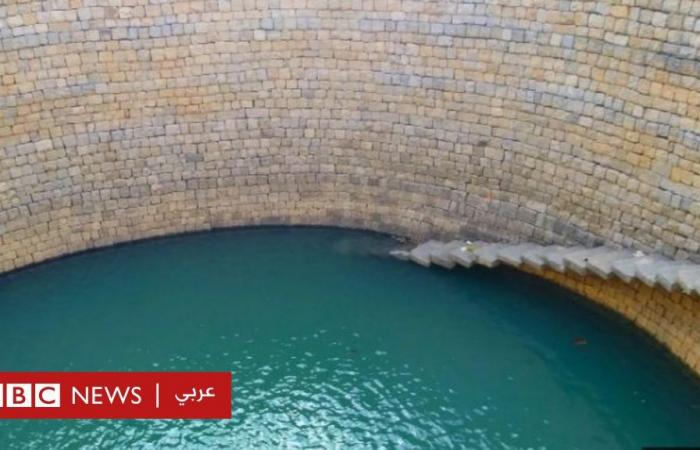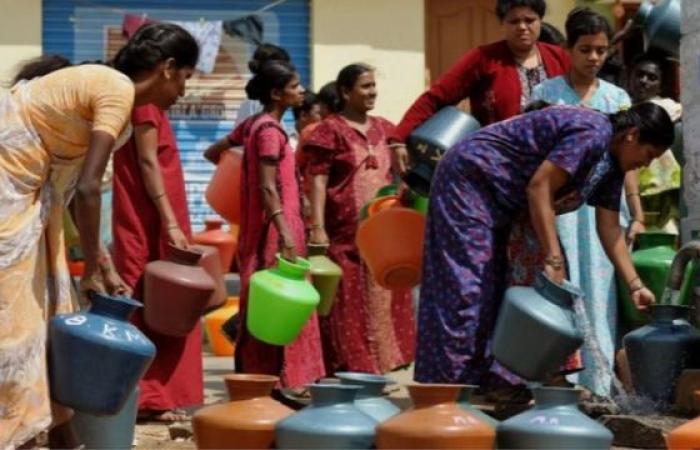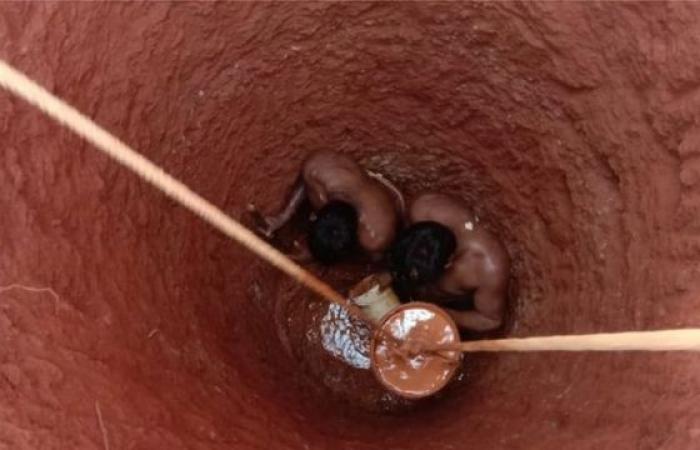- Ramya Kaushik
- BBC
3 hours ago
Image Released, Vishwanath Srikantaiah
Perhaps some visitors to Renuka High School, in the southeastern Indian city of Bangalore, expect to encounter a water well inside it. But getting acquainted with some information about the densely populated neighborhood in which this school is located, on the outskirts of Bangalore, may dispel their surprise.
Although this huge, fast-growing modern city is the capital of high-tech in India, and the region in which the school is located is not much different in its characteristics from the rest of Bangalore’s neighborhoods, that part of the city appears to be an isolated island. The reason this neighborhood is so different from the rest of the city is so vital is its lack of a piped network of drinking water.
Therefore, residents resorted to reviving an ancient method of obtaining water, which is digging wells, in order to irrigate the growing thirst in this area. The hand-dug well inside the school is part of a large-scale plan to drill one million wells across Bangalore. This challenging and epic mission may help protect the Indian city from the pressures of climate change.
City Thirsty
It is no secret that Bangalore has gained its place as one of the fastest growing cities in the entire Asian continent, at a heavy price. The water of the river closest to it, the Arkavati River, has long been insufficient to meet the population’s needs. Now, the Kaveri River is its lifeblood, supplying it with approximately 1,450 million liters of water per day. But the problem is that the closest point to the city is about 100 kilometers from it to the south.
Groundwater is another alternative to supplying the population with this important resource. The city already has nearly 400,000 so-called “boreholes”, which are holes in the ground or in landfills that are used to obtain samples of geological strata, waste or liquids such as water and oil. These “wells” were dug with permission from the authorities, but many of them were depleted, due to the excessive extraction of water from it.
These “wells” draw their water from deep aquifers, in which water is trapped between layers of fractured rocks, at a depth of 60 meters below the surface of the earth. The problem here is that the arrival of water to layers at this great depth is slow, and thus it may take several years to fill those layers again, which is not appropriate or practical to meet the needs of an expanding city.
Hita Unikrishnan, a researcher at the Sheffield Institute for Urban Studies, who studies the history of the water resources available to people in Bangalore, says the topography of this city “does not help it to have a large supply of water.”
On the other hand, Bangalore does not suffer from a shortage of rain. The average amount of rain that falls on it annually is large in every sense of the word, reaching 972 millimeters between April and November. The number of rainy days every year is about 60 days.
So where does all this water go? An answer to this question can be found in a study prepared by researchers from the Center for Environmental Studies at the Indian Institute of Science. The study indicates that the very intense paving of its streets and roads, in the period between 1973 and 2017, which brought the percentage of paved areas in it to an estimated 93 percent of its total area, led to the city not benefiting from the rainwater that falls on it.
This vision is being espoused by water conservation expert Vishwanat Shrikantaya, who leads a non-profit environmental initiative called the PIME Environmental Fund. Shrikantaya, whose initiative is leading the campaign to drill one million wells in Bangalore, says that the rainwater that enters the aquifers in normal conditions ranges between 3% and 10% of the total precipitation, but this percentage is completely absent if the authorities start building Above the soil.
In this case, the precipitation of that precious amount of rainwater on Bangalore does not lead to feeding the aquifers in it. Rather, this water runs under the buildings and floods unpaved roads, which leads to the clogging of the sewage network and the flooding of low-lying areas, a problem that is expected to worsen During the coming decades due to the phenomenon of climate change.
Stunning water
A few years ago, water from “sounding wells” would arrive at the Renuka School in tankers, which would come via congested roads from Bellandor or Eblor, about four kilometers from this educational institution. Those tanks brought up to 1,000 liters of water once or twice a week.
But this process was tedious, cumbersome and slow, and the school administration questioned the purity of the water obtained through it. This is due to the fact that the groundwater in many urban neighborhoods in Bangalore suffers from high levels of nitrate, pollution from sewage and what is known as “industrial pollution”. In addition to this, Lake Kaikunderley, located in the city, suffers from problems caused by pollution of its water with sewage, and dumping of waste into it as well.
Thus, residents have only one realistic alternative, which is digging wells. The Renuka School administration took this route in 2013, when it enlisted the services of traditional well drilling rigs to drill a deep, open well, with a depth of 14 feet (approximately 4.2 meters).
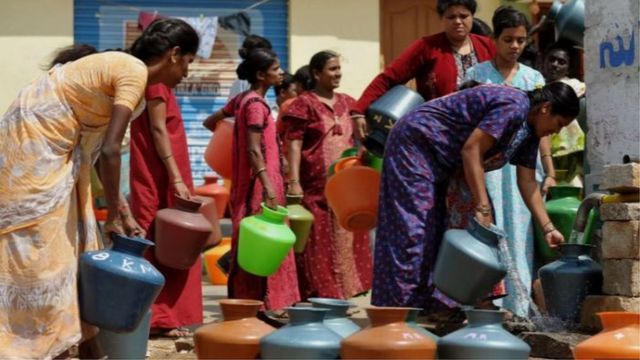
Image Released, Getty Images
In Bangalore, mastering the drilling and maintenance of wells and tackling any issues with a highly specialized and risky craft is also a challenge. Those who master this profession learn its methods from their skilled peers who are older than them, and pass the techniques used in this matter from one generation to the next. The sheikhs of that profession practiced their profession with skill, which resulted in none of them losing their lives or even any of their limbs, while digging wells in the depths of the earth, without being equipped with anything but picks and shovels.
The wells currently being drilled in Bangalore differ from the “sounding wells” that drain the deep aquifers. The wells that are being drilled are now open and shallow and “more likely to fill with water”, because they reach aquifers closer to the surface of the earth, and can quickly fill with rainwater.
But the issue of digging any of these wells is not as easy as it may seem. At present, those who want to dig such wells in their lands seek the help of experts in groundwater science (hydrogeology), and they also benefit from the services of those who apply the principles of a traditional Hindu system of architecture, in which the principles of design are harmonized with the elements of nature. This ancient engineering system is useful for identifying potential well drilling sites.
Once the drilling site is located, the drillers use a thread to measure the diameter of the cement rings, which will be used to line the earthen walls of the well. Before digging, a special prayer is given to the water goddess “gangama”.
While one of the members of the working team is assigned the task of digging the same, his companions take out the dirt that is bulldozed from the well, using plastic buckets. And if the soil in the drilling area is soft, a metal mesh suitable to the well dimensions shall be prepared and placed inside it to reduce the risk of collapsing its sides during the drilling process. This network is removed after completing this process, and cement rings are placed in place of it.
And when pores appear in the soil that covers the bottom of the well, indicating the existence of streams, the diggers know that they are about to reach their goal, and that they are on the outskirts of a layer of shallow groundwater, which stores in its interior quantities of rainwater, at a depth ranging between 10 feet and one hundred feet (3 meters to 30 meters) below the ground. After that, the water begins to seep into the newborn well. But that does not mean the end of the drilling process, which continues for another 2.5 to 3 meters (8-10 feet), which is both tedious and tedious.
It is noteworthy that the process of digging wells now is not much different in its details than it used to be generations ago, except with regard to the materials used to line the well from the inside, which are now represented in cement, not stones. A hundred years ago, stone blocks were stacked on the sides of the well from the inside without mortar, in order to allow water to seep through its gaps into it, coming from the aquifer. Now in place are placed precast concrete rings, each containing four inch-diameter gaps to allow water to reach.
Typically, drilling a well, which ranges from 9 to 12 meters (30 to 40 feet) deep, takes about three days, if undertaken by a team of seven or eight people. Thus, fathers, sons, siblings, uncles and cousins gather together to form such teams, and they share both burdens and profits.
The total profit of drilling a well in India ranges from 30,000 to 150,000 Indian rupees (410-2000 USD), depending on the depth of the well. This means that each participant in the drilling team earns an average of 1,200 rupees (16.40 dollars) per day, which is more than double the daily wage of a worker in urban India.
One of these workers, from a village on the outskirts of Bangalore that is home to 75 families working in the field, says he can guarantee the success of any digging he takes part in. And he asserts that he only gets his wages when the water flows into the well, adding, “I have never failed in my endeavor in that matter before that.”
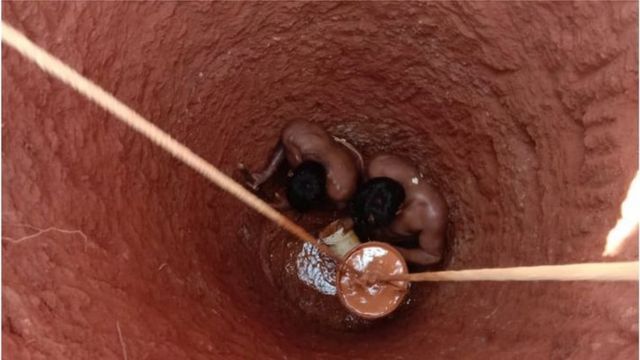
Image Released, Vishwanath Srikantaiah
Traditional well diggers in Bangalore do their work in hazardous conditions, using antique tools
Since the completion of the drilling of a water well in the Renuka School, the equivalent of 1,000 liters of water has been pumped twice a day, which is enough to supply the toilets, showers and gardens of this school. The well is filled again with water within two to three hours, thanks to the seepage from the lake in Bangalore, which underwent a comprehensive environmental clean-up in 2009. The well also benefits from a rainwater collection system located on the outside balcony of the school. The water level in the well matches that of the lake, according to the seasons of the year, as the soil between them acts as a natural filter.
Renuka School is one of the many institutions in Bangalore that have transformed to adopt sustainable water management methods, through cooperation with the PIME Environmental Fund. Chrykantaya, an expert at the fund, says there are already nearly 10,000 wells in Bangalore. But there is still a long way to go to achieve the goal of one million wells.
He adds by saying that using the services of traditional well diggers in the city to reach this end, would enable the city to benefit from an amount ranging between 50 percent and 60 percent of the rainwater that falls on it. This will also prevent Bangalore from experiencing floods due to the accumulation of rainwater. This man points out that his estimates indicate that achieving the goal of one million wells will lead to obtaining 140 million liters of water from that stored in shallow aquifers in the Indian city.
The skills of traditional well diggers play a crucial role in this regard, not only by virtue of their ability to actually participate in drilling operations, but also in light of their experience and knowledge about it.
These people, who participated in mapping the location of aquifers in southeast Bangalore, said Shobha Ramchandran, a water consultant at the Paim Fund, showed “a keen awareness of the wells already there, and the types of soil.” There, and whether there are layers of rocks, and other characteristics of the existing aquifers in that region. “
“The knowledge of the history of the open wells in the city is probably invaluable,” adds Ramchandran, who works closely with well diggers.
The process of obtaining water in this way is reliable on the one hand and affordable in terms of costs on the other hand. In open wells, one only needs to raise the water six meters (20 feet) in order to reach the surface of the earth. In contrast, if Bangalore were to benefit from the waters of the Kaveri River, the waters of this river would have to be raised to an estimated distance of 300 meters (984 feet). As a result, getting water from open wells costs only about 1 percent of the costs of fetching water from the Kaveri River.
Well diggers, who use traditional methods in this regard, are at the center of the shift in Bangalore towards obtaining water in this ancient way. Currently, the demand for the services of these workers is increasing. The authorities responsible for water supply and sanitation in Bangalore oblige all residents, without exception, to equip their homes with constructions that collect rainwater and recharge the aquifers with water. This indicates the possibility that more and more regular work will be available for traditional well drilling rigs in the next stage. It also represents promising news regarding the realization of Charkantaya’s dream of drilling one million wells in Bangalore.
In this context, the man says that the unique traditional method used to dig wells in this city can alleviate the problem of water scarcity that afflicts its residents. According to Shrikantaya, areas with shallow aquifers in Bangalore are able to create for themselves a “river that runs under the surface in them” with the help of traditional well diggers, rather than having to go to the trouble of bringing river water like Kaveri into the city’s neighborhoods.
These were the details of the news The mystery of the Indian city that seeks to drill a... for this day. We hope that we have succeeded by giving you the full details and information. To follow all our news, you can subscribe to the alerts system or to one of our different systems to provide you with all that is new.
It is also worth noting that the original news has been published and is available at saudi24news and the editorial team at AlKhaleej Today has confirmed it and it has been modified, and it may have been completely transferred or quoted from it and you can read and follow this news from its main source.

